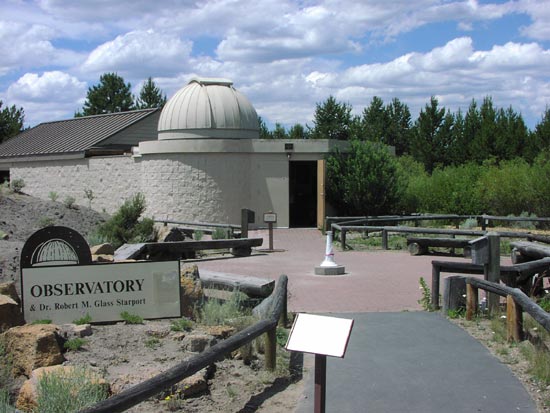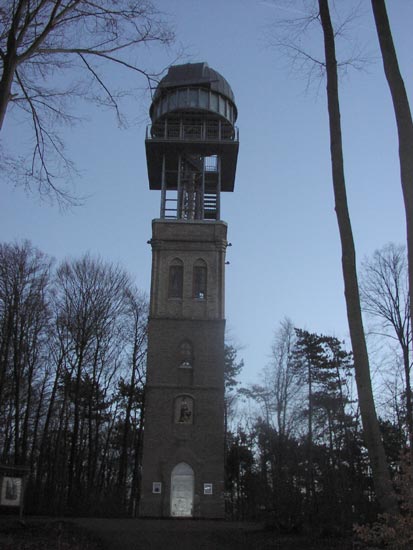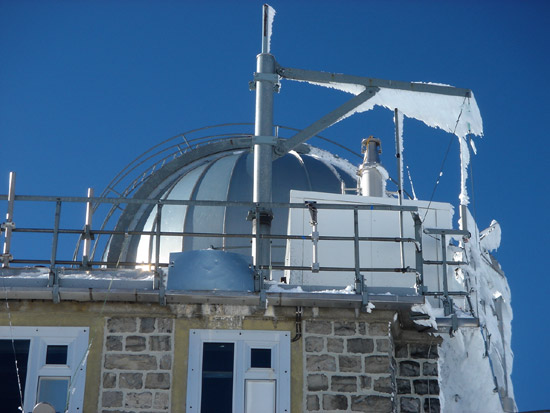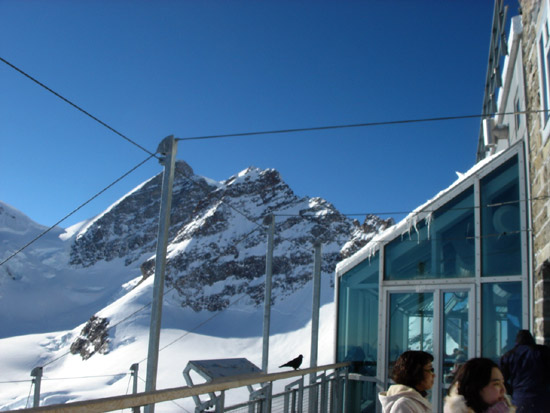

It begins with a phone call from my sister. A few years ago it was “How would you like to go to China?” More recently it was the Virgin Islands, Oregon, New York, Europe, Vermont (I’m convinced she was a travel agent in a previous life).
In my last article I told you about my trip to New York (see “Two Days in Manhattan” by Dave Snyder, December, 2004), this time I’m going to tell you about two other trips and some observatories I saw along the way.

My sister and brother-in-law are part owners of a condo in Sunriver, located in central Oregon; going to Sunriver has become an annual ritual for us. There’s lots of things to do there, but I’ll focus on just one, the Sunriver Observatory (shown in the photograph above).
The building is about the same size as our McMath telescope building. Like our building there is roof which can be moved from closed to open (it is partially open in the photograph); unlike our building the roof is pitched and there is a dome.
Your first question should be, “how dark is the sky?” Surprisingly dark. There are several reasons for this.
(Unfortunately the lack of water leads to another problem, forest fires. On one of our visits, there was a forest fire, thankfully a healthy distance from us. However the smoke blackened the sky for a while. In case there was any doubt about what was happening, pieces of burnt wood starting raining from the sky. Later on we found these pieces of burnt wood everywhere).
On the other hand the horizon is not perfectly flat. The biggest obstruction is Mount Bachelor (9,065 feet), 18 miles to the west. And there is the volcano to the north. However I haven’t noticed this being a big problem.
The observatory is run by what is known as the “Sunriver Nature Center & Observatory.” They have a mixture of paid staff and volunteers. The Observatory’s purpose is to present the night sky to the general public and to provide educational programs for children. As far as I know, no one does scientific research here, but there is an amateur community that makes use of the observatory. Unlike us, they charge an admission fee to enter the observatory. There is a small gift shop (located near the observatory, but not visible in the photograph) that includes, among other things, a limited assortment of astronomy equipment. The main telescope is a 20” Ritchey-Chretien, and they have a collection of smaller instruments. All of the telescopes, including the 20” were donated.
During July and August they have daily solar viewing, and night sky viewing 6 days a week. There are open houses in other months, but less often. In the summer they will have you sit on wood benches in front of the building (in the photograph you can see these benches arranged in a circle). The presenter will show you the Milky Way and the various summer constellations. Later you can look through the 20” or other telescopes set up nearby. If you are nice, they might let you borrow one of the Observatory’s several 8” dobs (to be honest I haven’t borrowed any of their telescopes, but apparently they encourage children to try their hand observing on the dobs).
They also have astronomy talks on a regular basis. Once a year, in July, there is the Mount Bachelor Star Party (held, as you might guess, at Mount Bachelor which as I mentioned earlier is 18 miles to the west of Sunriver). I’ve never attended so I don’t know much about it beyond the information available on the web. It is hosted by Mount Bachelor Ski Education Foundation and the Sunriver Nature Center & Observatory.
You can find more information about the observatory at: http://www.sunrivernaturecenter.org/ You can find more information about the Mount Bachelor Star Party at http://www.mbsp.org/ As I hinted above, Oregon is not the only place I’ve visited. A year ago, we took a trip through Switzerland and Germany.

One of the stops was the German town of Hildesheim. Shortly after we arrived, we took a walk through the woods and came across a tall tower (shown above). You can get some sense of how tall it is by looking at the shape at the bottom of the tower; it’s a door. At the top, there is an observatory dome. The Observatory has open houses, but we were only in Hildesheim for a couple days and did not have time to attend.
I was curious about this unusual structure. So I used Google to get more information.
I first tried entering “Hildesheim Observatory.” That didn’t work. I quickly realized that I needed to enter a request in German to find information about a German observatory, so I tried “Hildesheim Sternwarte.” “Stern” is of course German for “star” and “Sternwarte” is German for “observatory.” The result was a number of web pages, all in German. Google notices that they are in German and offers to translate them into English. Since my German is rusty, I accepted the offer.
If you try this, the pages you get are not perfect translations. These computer translations include awkward phrases that clearly were not written by a human, or at least a human who is a native english speaker. They often are difficult to interpret, however with effort you can figure out a lot as I was able to do in this case.
The tower has the name “Der Gelbe Turm” or “The Yellow Tower.” The tower itself was built in the late 1800’s and refurbished in 1996.
The telescope, a 600 millimeter Cassegrain, also dates to 1996. Coincidently 600 millimeters is slightly less than 24 inches, so this is roughly similar to our 24 inch McMath Cassegrain, however the telescope has a more modern design than the McMath. As near as I can tell it never was a research instrument, but used solely for amateur observing, public open houses and the education of local school children. Unlike Sunriver, light pollution is a problem at this location (as it is in much of Western Europe). The web site I found was http://www.vhs-hildesheim.de/gelber_turm/. However unless you are fluent in German you’ll need to use a translation service to read it. You might try repeating the procedure I explained above.
By the way, during the same trip, we spent a couple days in Mürren Switzerland. (I probably wouldn’t have thought to include this if John Causland hadn’t mentioned that he recently took a skiing trip to the same area). Mürren is located in the hills on the same mountain as Jungfraujoch, one of highest peaks in Europe (Jungfraujoch is the German name for the peak, but English maps often call it simply “the Top of Europe,” even though that is not a reasonable translation of the word).


We did not visit it, but there is an observatory near the peak (the Jungfraujoch Observatory of course). The observatory is part of the logo of the Jungfraujoch Railway which bills itself as the highest railroad in Europe and offers rides to the peak (but tickets to the peak are expensive, the prices I’ve seen are about 160 Swiss Francs or about US$130). If you travel through that part of Switzerland and look at your train ticket, you will see a picture of the observatory (there are no roads through these mountains, if you want to get to the peak you have no alternatives but the train). John Causland gave me two photos he took of the Observatory building (shown above).
Unlike the two observatories I mentioned earlier, this one is heavily involved with scientific research. The formal name for the umbrella organization which runs the Jungfraujoch Observatory is the International Foundation High Altitude Research Stations Jungfraujoch and Gornergrat. It also runs another observatory, the Gornergrat roughly 80 kilometers south of Jungfraujoch. Gornergrat is located on a different mountain peak near the Matterhorn and roughly 80 kilometers south of Jungfraujoch.
They are engaged in a number of research projects, only some of which are astronomy related. A quick look at the projects suggested to me they were primarily grouped into the following categories.
There is more information about the Jungfraujoch and Gornergrat Observatories at http://www.ifjungo.ch/ . Unlike the previous web site, this one is mostly in English (though I noticed they slipped and included an occasional German phrase and some of the links are to web sites in German).